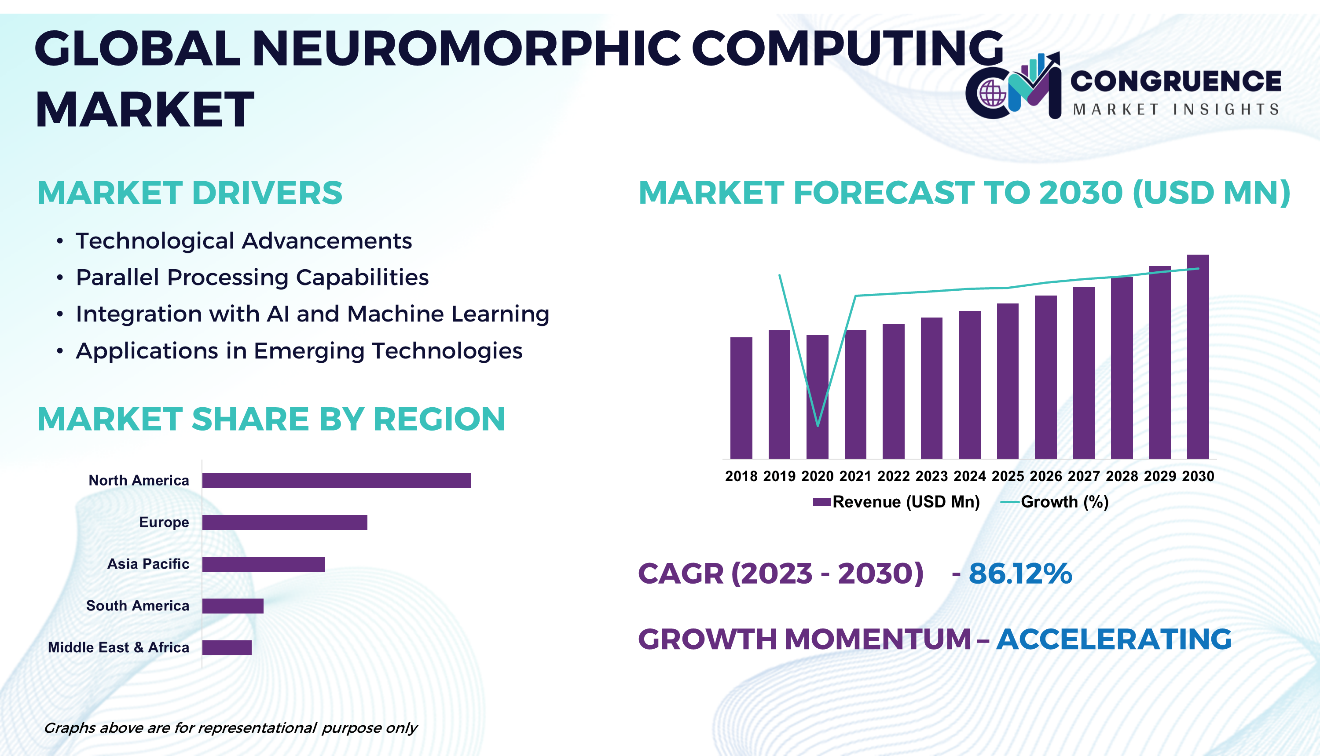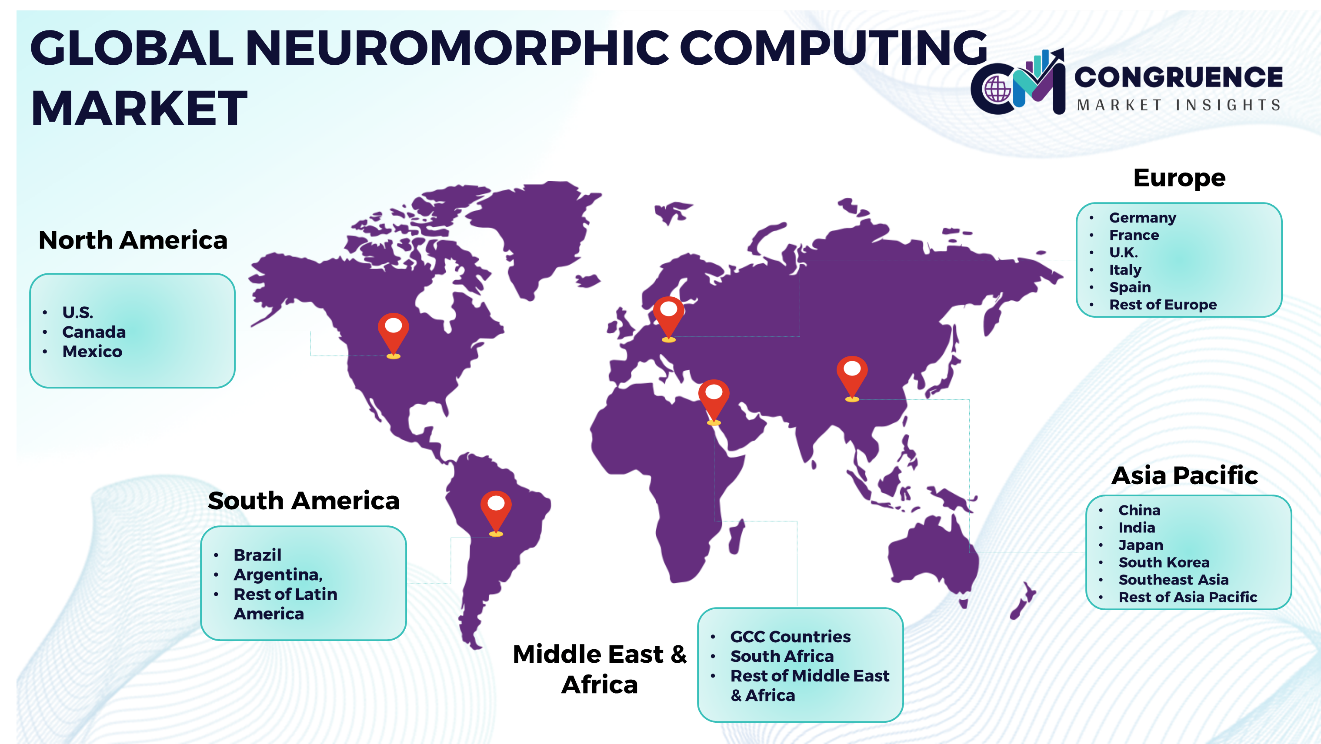Reports
The Global Neuromorphic Computing Market is expected to expand at a CAGR of 86.12% between 2023 and 2030. Neuromorphic computing epitomizes a groundbreaking paradigm inspired by the neural architecture of the human brain, offering unparalleled efficacy in processing extensive datasets with adaptability and efficiency. Technological advancements in neuromorphic hardware and software have propelled this domain, facilitating the creation of immensely parallel, energy-efficient computing systems that emulate biological neural networks. Integration with conventional computing architectures and emerging technologies like artificial intelligence and machine learning fuels innovation and broadens the applicability of neuromorphic computing across various sectors. The market landscape for neuromorphic computing is dynamic, with prominent entities such as Intel, IBM, and Qualcomm spearheading research, development, and commercialization endeavors, complemented by startups and research institutions, thus shaping the trajectory of cognitive computing.

Neuromorphic Computing Market Major Driving Forces
Technological Advancements: Continuous progress in neuromorphic hardware and software drives innovation, enabling the development of highly efficient and adaptable computing systems inspired by the human brain's neural architecture.
Parallel Processing Capabilities: Neuromorphic computing offers highly parallel processing capabilities, allowing for the efficient handling of large-scale datasets and complex computational tasks, which is increasingly essential in various industries.
Integration with AI and Machine Learning: Integration with artificial intelligence (AI) and machine learning technologies extends the applicability of neuromorphic computing, enabling advanced pattern recognition, decision-making, and autonomous functionality across diverse domains.
Applications in Emerging Technologies: Neuromorphic computing finds applications in emerging technologies such as robotics, autonomous vehicles, and edge computing, driving demand for its unique capabilities in real-time processing and adaptive learning.
Neuromorphic Computing Market Key Opportunities
Enhanced Cognitive Capabilities: Neuromorphic computing offers opportunities for the development of cognitive computing solutions with advanced pattern recognition, decision-making, and learning capabilities, paving the way for innovative applications in various domains.
Real-Time Processing: Neuromorphic computing's ability to perform real-time processing of sensory data opens opportunities for applications in areas such as autonomous vehicles, robotics, and augmented reality, where rapid decision-making is crucial.
Personalized Healthcare Solutions: Neuromorphic computing enables the analysis of large-scale biomedical data for personalized diagnostics, treatment planning, and drug discovery, offering opportunities to revolutionize healthcare delivery and improve patient outcomes.
Edge Computing: Neuromorphic computing's scalability and efficiency make it well-suited for edge computing applications, enabling processing and analysis of data closer to the source, thereby reducing latency and bandwidth requirements in IoT and other edge deployments.
Neuromorphic Chips and Hardware: Opportunities exist for the development of neuromorphic chips and hardware optimized for specific applications and industries, driving advancements in performance, power efficiency, and miniaturization.
Neuromorphic Computing Market Key Trends
· Technological advancements in neuromorphic hardware drive continual improvements in performance, energy efficiency, and scalability of computing systems.
· Integration with AI and machine learning methodologies enables the development of sophisticated systems with enhanced learning capabilities.
· Heightened awareness of ethical and societal implications, including data privacy and bias concerns, accompanies the increasing prominence of neuromorphic computing technologies.
· Initiatives aimed at standardizing architectures and interfaces drive ecosystem growth, facilitating collaboration and innovation within the field.
· Neuromorphic computing finds application in edge computing scenarios, enabling real-time processing and analysis of sensory data for various use cases.
· Emphasis on developing software tools and frameworks facilitates the design, simulation, and optimization of neuromorphic computing systems.

Market Competition Landscape
In the market competition landscape of neuromorphic computing, entities engage in rigorous competition, fostering innovation and technological advancements. This environment encourages the development of specialized solutions tailored to diverse industry needs. Key factors influencing competition include technological expertise, research and development capabilities, and the ability to address emerging market demands effectively. Collaboration and strategic partnerships are common strategies employed by market participants to leverage complementary strengths and stay competitive in the rapidly evolving landscape.
Key players in the global Neuromorphic Computing market implement various organic and inorganic strategies to strengthen and improve their market positioning. Prominent players in the market include:
· Intel Corporation
· IBM Corporation
· BrainChip, Inc.
· HRL Laboratories
· Qualcomm Technologies, Inc.
· Hewlett Packard Enterprise (HPE)
· Samsung Electronics Co., Ltd.
· General Vision Inc.
· Vicarious
· Numenta
· Hewlett Packard Enterprise Development LP
· Knowm Inc.
· Applied Brain Research, Inc.
· SynSense
· Vicarious
· Syntiant Corp.
· Brain Corporation
|
Report Attribute/Metric |
Details |
|
Base Year |
2022 |
|
Forecast Period |
2023 – 2030 |
|
Historical Data |
2018 to 2022 |
|
Forecast Unit |
Value (US$ Mn) |
|
Key Report Deliverable |
Revenue Forecast, Growth Trends, Market Dynamics, Segmental Overview, Regional and Country-wise Analysis, Competition Landscape |
|
Segments Covered |
· By Offering (Hardware, Software, and Services) · By Computing Architecture (Digital Neuromorphic Computing, and Analog Neuromorphic Computing) · By Technology (Spiking Neural Networks (SNN), Memristor-based Computing, and Others) · By Application (Image Recognition and Processing, Signal Processing, Data Mining and Analysis, Machine Learning, Robotics, and Others) · By End Use Industry (Consumer Electronics, Manufacturing, IT and Telecommunications, Healthcare, Automotive, and Others) |
|
Geographies Covered |
North America: U.S., Canada and Mexico Europe: Germany, France, U.K., Italy, Spain, and Rest of Europe Asia Pacific: China, India, Japan, South Korea, Southeast Asia, and Rest of Asia Pacific South America: Brazil, Argentina, and Rest of Latin America Middle East & Africa: GCC Countries, South Africa, and Rest of Middle East & Africa |
|
Key Players Analyzed |
Intel Corporation, IBM Corporation, BrainChip, Inc., HRL Laboratories, Qualcomm Technologies, Inc., Hewlett Packard Enterprise (HPE), Samsung Electronics Co., Ltd., General Vision Inc., Vicarious, Numenta, Hewlett Packard Enterprise Development LP, Knowm Inc., Applied Brain Research, Inc., SynSense, Vicarious, Syntiant Corp., Brain Corporation |
|
Customization & Pricing |
Available on Request (10% Customization is Free) |
